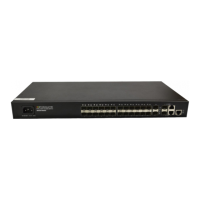ARP Configuration
Chapter 12. ARP Configuration
12.1 ARP Overview
12.1.1 ARP Function
Address Resolution Protocol (ARP) is used to resolve an IP address into a data link layer
address.
An IP address is the address of a host at the network layer. To send a network layer packet
to a destination host, the device must know the data link layer address (such as the MAC
address) of the destination host. To this end, the IP address must be resolved into the
corresponding data link layer address.
Unless otherwise stated, the data link layer addresses that appear in this chapter refer to
the 48-bit Ethernet MAC addresses.
ARP Address Resolution Process as below:
Suppose that Host A and Host B are on the same subnet and that Host A sends a
message to Host B, as show in Figure 12-1. The resolution process is as follows:
1) Host A looks in its ARP mapping table to see whether there is an ARP entry for Host B. If
Host A finds it, Host A uses the MAC address in the entry to encapsulate the IP packet into a
data link layer frame and sends the frame to Host B.
2) If Host A finds no entry for Host B, Host A buffers the packet and broadcasts an ARP
request, in which the source IP address and source MAC address are respectively the IP
address and MAC address of Host A and the destination IP address and MAC address are
respectively the IP address of Host B and an all-zero MAC address. Because the ARP
request is sent in broadcast mode, all hosts on this subnet can receive the request, but only
the requested host (namely, Host B) will process the request.
3) Host B compares its own IP address with the destination IP address in the ARP request.
If they are the same, Host B saves the source IP address and source MAC address into its
ARP mapping table, encapsulates its MAC address into an ARP reply, and unicasts the reply
to Host A.
4) After receiving the ARP reply, Host A adds the MAC address of Host B into its ARP
mapping table for subsequent packet forwarding. Meanwhile, Host A encapsulates the IP
packet and sends it out.

